Waste Management Market by Waste Type (Hazardous Waste, E-Waste, Municipal Solid Waste, Medical Waste, Construction & Demolition, Non-Hazardous Industrial Waste), Disposal (Open Dumping, Incineration/Combustionl), Source & Region - Global Forecast to 2029
[250 Pages Report] The global Waste Management Market is projected to reach USD 1598.1 billion by 2029 from an estimated USD 1219.6 billion in 2024, at a CAGR of 5.6% during the forecast period. Waste management is an important part of environmental sustainability and public health. It entails the collection, transportation, processing, recycling, and disposal of diverse wastes produced by households, businesses, industries, and institutions. Governments and international organizations are implementing harsher waste management policies, such as extended producer responsibility and aggressive plastic waste reduction objectives. The implementation of circular economy ideas is changing waste management by emphasizing a continuous cycle of repurposing, reusing, and recycling resources. This method not only eliminates waste, but it also encourages sustainability and resource optimisation. Advances in decomposition technologies are providing ground-breaking waste management solutions, such as faster and more effective means of breaking down organic and inorganic garbage.
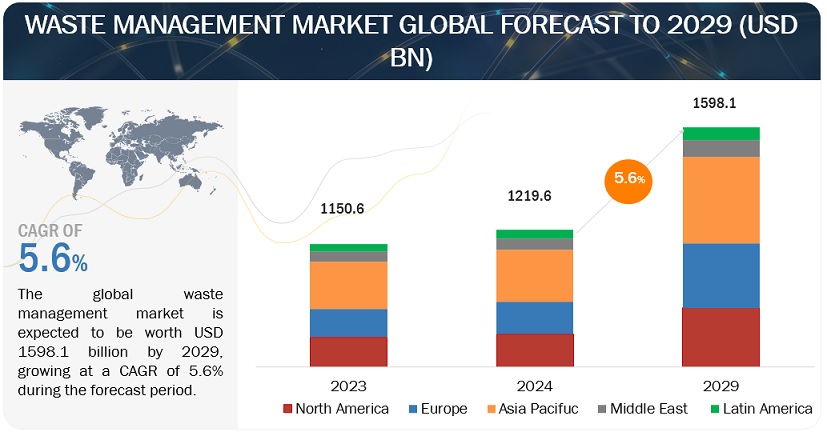
To know about the assumptions considered for the study, Request for Free Sample Report
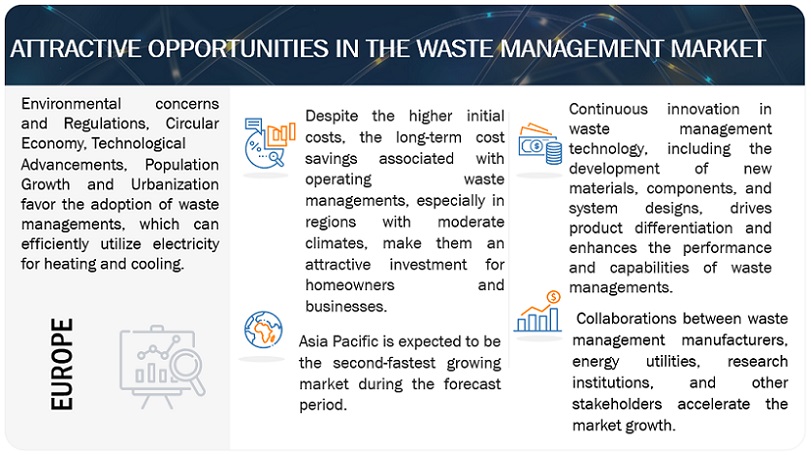
To know about the assumptions considered for the study, download the pdf brochure
Waste management Market Dynamics
Driver: Technological advancements in waste management
Technological advancements in waste management is a driver for providing waste management services. These advancements have made waste management more efficient and sustainable, transforming the way we handle waste. Some of the innovative technologies that have been developed include smart waste bins, waste level sensors, AI recycling robots, and renewable energy solutions. Smart waste bins are equipped with sensors that can detect the level of waste inside them. This allows waste management companies to optimize their collection routes, reducing the number of trips needed to collect waste and improving efficiency. Waste level sensors can also be installed in landfills and transfer stations, allowing for more accurate monitoring of waste volumes and better management of waste disposal. AI recycling robots are another innovative technology that has been developed to improve waste management. These robots use artificial intelligence to sort recyclable materials from non-recyclable materials, increasing the efficiency of recycling processes. This not only reduces the amount of waste sent to landfills but also helps to conserve resources and reduce the environmental impact of waste disposal.
Restraint: Lack of Infrastructure
Insufficient waste collection systems can adversely impact waste management practices, resulting in irregular or incomplete gathering of waste from diverse sources like households, businesses, and public areas. This leads to a accumulation of uncollected waste that ends up in landfills without proper sorting or processing. In many developing countries, inadequate waste collection systems contribute to environmental and health challenges, as seen in parts of Sub-Saharan Africa where rapid urbanization surpasses the development of waste management infrastructure. Cities and towns struggle with inefficient waste collection systems unable to cope with the growing waste volume from expanding populations, causing garbage to accumulate in unsightly and unsanitary conditions on streets, open spaces, and waterways,
Opportunities: Circular economy & recycling
The adoption of recycling and the principle of a circular economy presents novel opportunities in waste management, emphasizing sustainable practices and closing the loop from extraction to disposal. The circular economy advocates for product design that minimizes waste and optimizes material usage, positioning waste management as the final step. This approach prioritizes the efficient use of materials, striving to prolong their lifespan through strategies like recycling, reusing, and repairing. This stands in stark contrast to the conventional linear economy, where materials are extracted, used, and often disposed of in landfills or incinerators.
Challenges: Illegal trading of E-waste
E-waste discarded from developed countries is exported to Asia Pacific countries, such as China, India from the countries in the Middle east, for the purpose of reuse or repair. Some electronic products are repaired, while some of them are reused. However, most of these products are simply dumped in these countries since no facilities exist to safely recycle these products. The problem of illegal dumping persists in all developing countries. According to government legislation and laws, it is illegal to export broken electronic goods. The elements toxic to the environment are not removed from these products, thereby causing pollution in developing countries.
Waste management Market Ecosystem
In this market, prominent companies stand out as well-established and financially stable providers of Waste management products and services. With years of experience, these companies boast a diverse product portfolio, cutting-edge technologies, and robust global sales and marketing networks. Their proven track record in the industry positions them as reliable and trusted partners for customers seeking Waste management solutions. These companies have demonstrated their ability to adapt to market dynamics and consistently deliver high-quality products and services, making them leaders in meeting the demands of the energy and power sector. Prominent companies in this market include WM Intellectual Property Holdings, L.L.C. (US), Suez (France), Veolia (France), Republic Services (US) & Waste Connections (US) are the market leaders in the Waste management market.
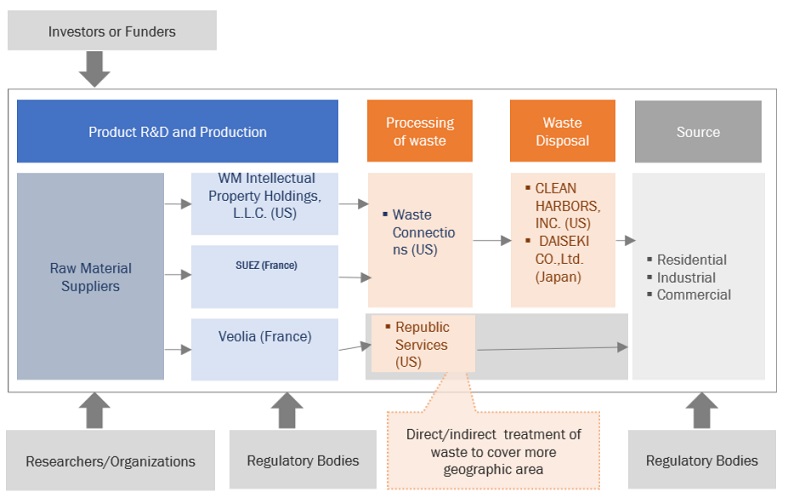
The Industrial segment, by source, is expected to be the largest market during the forecast period.
This report segments the waste management market based on source into three categories: residential, commercial, and industrial. The industrial segment is expected to be the largest market during the forecast period. Industrial activities generate a large amount of garbage, both hazardous and non-hazardous, necessitating specialist waste management services to address these different waste streams. The growing awareness of environmental concerns and the emphasis on sustainable practices has prompted enterprises to use recycling methods to efficiently manage their trash, making recycling the dominating type in the worldwide industrial waste management market. The emphasis on circular economy principles, as well as government rules supporting sustainability, contribute to industrial waste management's dominant position in the total waste management business.
By Disposal type, Landfilling is expected to be the largest segment during the forecast period.
Based on the Disposal method, the waste management market is segmented into six categories: Open Dumping, Incineration/Combustion, Landfill, Recycling, Composting & Anaerobic Digestion. Landfilling is expected to be the largest segment during the forecast period. Landfilling is a popular waste disposal strategy for a variety of reasons, as detailed in the following sources. Landfills are vital for proper solid waste disposal, limiting garbage entering the environment, preventing disease transmission, and preserving clean neighborhoods. Landfills follow environmental regulations and standards to ensure proper garbage disposal. They are monitored and managed to reduce the risk to public health and the environment..
Asia Pacific : The fastest growing region in the Waste management market.
Asia Pacific is expected to be the fastest growing region in the waste management market between 2024–2029. Asia-Pacific is the world's fastest-growing economic powerhouse, bringing millions out of poverty and accelerating urbanization. This expansion leads to increased trash output, demanding efficient waste management techniques. Rapid industrialization in countries such as China, India, Indonesia, Russia, Japan, and others has resulted in increased industrial waste production, necessitating modern waste treatment infrastructure. The increase of plastic garbage in the Asia-Pacific area has sparked calls for better waste management and recycling activities.
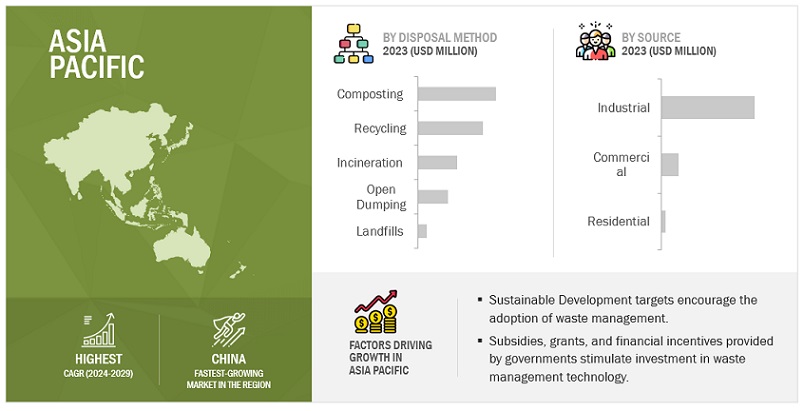
Key Market Players
The waste management market is dominated by a few major players that have a wide regional presence. The major players in the waste management market include WM Intellectual Property Holdings, L.L.C. (US), Suez (France), Veolia (France), Republic Services (US) & Waste Connections (US) are the market leaders in the Waste management market. Between 2019 and 2023, Strategies such as new product launches, contracts, agreements, partnerships, collaborations, acquisitions, and expansions are followed by these companies to capture a larger share of the waste management market.
Get online access to the report on the World's First Market Intelligence Cloud
- Easy to Download Historical Data & Forecast Numbers
- Company Analysis Dashboard for high growth potential opportunities
- Research Analyst Access for customization & queries
- Competitor Analysis with Interactive dashboard
- Latest News, Updates & Trend analysis
Request Sample Scope of the Report
Get online access to the report on the World's First Market Intelligence Cloud
- Easy to Download Historical Data & Forecast Numbers
- Company Analysis Dashboard for high growth potential opportunities
- Research Analyst Access for customization & queries
- Competitor Analysis with Interactive dashboard
- Latest News, Updates & Trend analysis
|
Report Metric |
Details |
|
Market size available for years |
2019–2029 |
|
Base year considered |
2023 |
|
Forecast period |
2024–2029 |
|
Forecast units |
Value (USD Million) |
|
Segments Covered |
Waste management Market by Waste type, Disposal method, Source and Region. |
|
Geographies covered |
North America, Europe, Asia Pacific, Latin America, and Middle East & Africa. |
|
Companies covered |
WM Intellectual Property Holdings, L.L.C. (US), SUEZ (France), Veolia (France), Waste Connections (US), Republic Services (US), Biffa (UK), CLEAN HARBORS, INC. (US), Covanta Holding Corporation (US), DAISEKI CO.,Ltd. (Japan), Hitachi Zosen Corporation (Japan), GFL environmental Inc. (Canada), BINGO INDUSTRIES (Australia), Stericycle, Inc. (US), REMONDIS SE & Co. KG (Germany), URBASER (Spain), FCC Environmental Services (Austria), BioMedical Waste Solutions (US), Valicor (US), Recology (US), Estre (Brazil), RecyGlo Company Pte. Ltd. (Myanmar), Saahas Zero Waste (India), Recycle Track Systems, Inc. (US), Recycling Technologies Ltd (England), Rekosistem (Indonesia). |
This research report categorizes the Waste management Market by Waste type, Disposal method, Source and Region.
On the basis of Waste type, the Waste management market has been segmented as follows:
- Hazardous Waste
- E-Waste
- Municipal Solid Waste
- Medical Waste
- Construction & Demolition Waste
- Non- Hazardous Industrial Waste
On the basis of Disposal method, the Waste management market has been segmented as follows:
- Open Dumping
- Incineration/Combustion
- Landfill
- Recycling
- Composting & Anaerobic Digestion
On the basis of Source, the Waste management market has been segmented as follows:
- Residential
- Commercial
- Industrial
Based on region, the Waste management market has been segmented as follows:
- North America
- Europe
- Asia Pacific
- Middle East & Africa
- Latin America
Recent Developments
- In November 2023, Biffa has acquired Hamilton Waste and Recycling Limited (HWR), Scotland’s leading construction and demolition (C&D) waste collection and processing business.?The acquisition of HWR is a significant step for Biffa, expanding its waste capabilities in the construction and demolition sector, further underpinning its commitment to low-carbon collections and material processing.
- In July 2023, SUEZ has acquired 60% share of APBB (Czech Republic), suez is extending the scope of its activities in the Czech Republic by entering the municipal and industrial waste management and green energy production markets.
- In November 2022, Veolia and Abu Dhabhi National Oil company Refining has signed a historic agreemen for the treatment of hazardous industrial waste.
- In September 2022, WM Intellectual Property Holdings, L.L.C. acquired Avangard Innovative's U.S. business, which will operate as Natura PCR – an independent company expected to scale and grow recycling capacity to produce an estimated 400 million pounds per year of post-consumer resin (PCR) in five years.
Frequently Asked Questions (FAQ):
What is the current size of the Waste management market?
The current market size of the waste management market is USD 1219.6 billion in 2024.
What are the major drivers for the Waste management market?
Government subsidies, tax credits, and rebates for the installation of waste management services are incentivizing consumers to adopt this services are some of the major drivers for the waste management market.
Which is the largest region during the forecasted period in the waste management market?
North America is expected to dominate the Waste management market between 2024–2029, followed by Asia Pacific, Europe.
Which is the largest segment, by source, during the forecasted period in the waste management market?
The Industrial waste segement by source is expected to be the largest market during the forecast period.
Which is the largest segment, by disposal method, during the forecasted period in the waste management market?
Landfilling is expected to be the largest market during the forecast period by application. The growth is attributed due to the penetration of renewables in the energy system. .
To speak to our analyst for a discussion on the above findings, click Speak to Analyst
The study involved major activities in estimating the current size of the waste management market. Exhaustive secondary research was done to collect information on the peer and parent markets. The next step was to validate these findings, assumptions, and sizing with industry experts across the value chain through primary research. Both top-down and bottom-up approaches were employed to estimate the total market size. Thereafter, market breakdown and data triangulation were used to estimate the market size of the segments and subsegments.
Secondary Research
This research study on the waste management market involved the use of extensive secondary sources, directories, and databases, such as Eurostat (Luxembourg), The Organisation for Economic Co-operation and Development (OECD) (France), The World Bank Group (US), Food and Agriculture Organization of the United Nations (FAO) (Italy), United Nations Environment Programme (UNEP), UNIDO United Nations Industrial Development Organization (Austria) to collect and identify information useful for a technical, market-oriented, and commercial study of the waste management market. The other secondary sources included annual reports, press releases & investor presentations of companies, white papers, certified publications, articles by recognized authors, manufacturer associations, trade directories, and databases.
Primary Research
The waste management market comprises several stakeholders, such as waste management manufacturers, technology providers, and technical support providers in the supply chain. The demand side of this market is characterized by the rising demand for waste management in various sources such as residential, industrial, and commercial sectors. The supply side is characterized by rising demand for contracts from the industrial sector and mergers & acquisitions among big players. Various primary sources from both the supply and demand sides of the market were interviewed to obtain qualitative and quantitative information. Following is the breakdown of primary respondents:
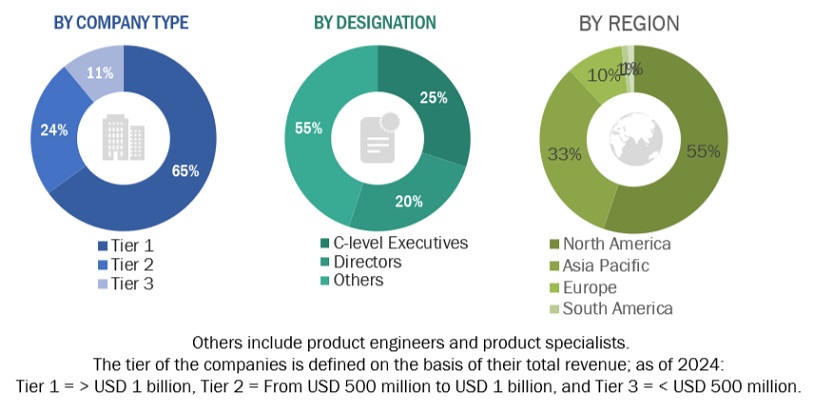
To know about the assumptions considered for the study, download the pdf brochure
Market Size Estimation
Both top-down and bottom-up approaches were used to estimate and validate the total size of the waste management market. These methods were also used extensively to estimate the size of various subsegments in the market. The research methodology used to estimate the market size includes the following:
- The key players in the industry and market have been identified through extensive secondary research, and their market share has been determined through primary and secondary research.
- The industry’s value chain and market size, in terms of value, have been determined through both primary and secondary research processes.
- All percentage shares, splits, and breakdowns have been determined using secondary sources and verified through primary sources.
Waste management Market Size: Top-Down Approach
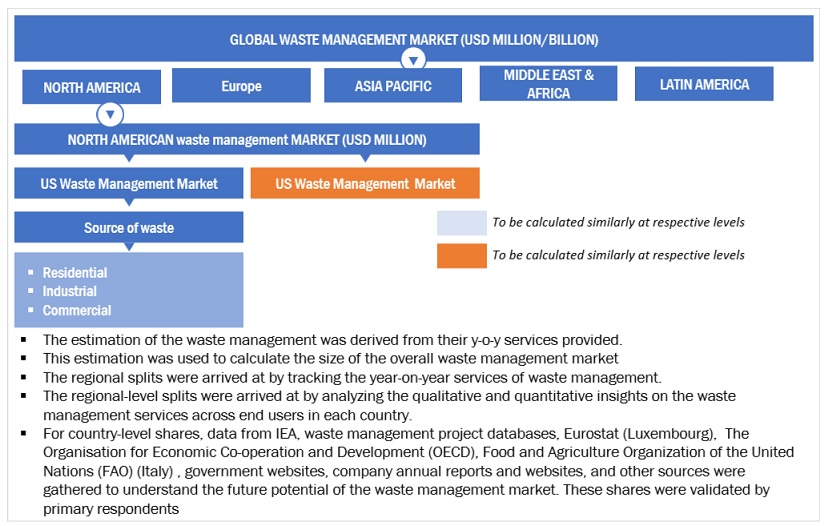
To know about the assumptions considered for the study, Request for Free Sample Report
Waste management Market Size: Bottom-Up Approach
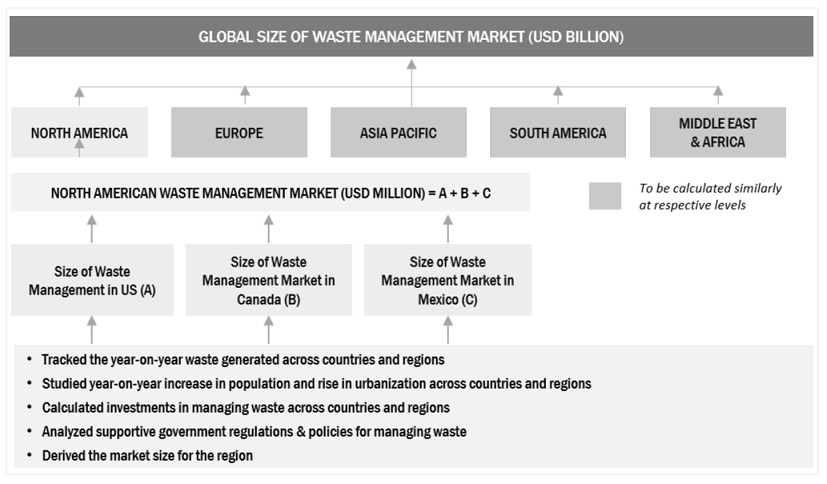
Data Triangulation
After arriving at the overall market size from the above estimation process, the total market has been split into several segments and subsegments. Data triangulation and market breakdown processes have been employed to complete the overall market engineering process and arrive at the exact statistics for all the segments and sub-segments, wherever applicable. The data has been triangulated by studying various factors and trends from both the demand- and supply sides. Along with this, the market has been validated using both the top-down and bottom-up approaches.
Market Definition
Waste management refers to the various schemes and strategies used to manage and dispose of different types of waste, including industrial, biological, household, municipal, organic, biomedical, and radioactive wastes. It encompasses processes such as waste collection, transport, treatment, and disposal, as well as monitoring and regulation of the waste management process and waste-related laws, technologies, and economic mechanisms. It involves the implementation of comprehensive strategies to efficiently manage waste, including methods such as recycling, composting, incineration, landfills, bioremediation, waste to energy, and waste minimization.
Key Stakeholders
- Maintenance and other major service providers
- Waste management component manufacturers
- Government and research organizations
- Institutional investors
- National and local government organizations
- Waste management equipment manufacturers
- Waste management manufacturing companies
- Technology standard organizations, forums, alliances, and associations
State and national regulatory authorities Objectives of the Study
- To define, describe, segment, and forecast the size of the waste management market based on waste type, disposal method and by source in terms of value.
- To describe and forecast the market for five key regions: Asia Pacific, North America, Europe, Latin America, and Middle East & Africa, along with their country-level market sizes in terms of value.
- To forecast the waste management market by region, in terms of volume
- To provide detailed information regarding key drivers, restraints, opportunities, and challenges influencing the growth of the market.
- To strategically analyze micro markets with respect to individual growth trends, prospects, and contributions to the overall market size.
- To provide the supply chain analysis, trends/disruptions impacting the customer’s business, market map, pricing analysis, and regulatory analysis of the waste management market.
- To analyze opportunities for stakeholders in the waste management market and draw a competitive landscape of the market.
- To strategically analyze the ecosystem, tariffs and regulations, patent landscape, trade landscape, Porter’s five forces, and case studies pertaining to the market under study.
- To benchmark market players using the company evaluation quadrant, which analyzes market players on broad categories of business and product strategies adopted by them.
- To compare key market players with respect to product specifications and applications.
- To strategically profile key players and comprehensively analyze their market rankings and core competencies.
- To analyze competitive developments, such as contracts & agreements, investments & expansions, mergers & acquisitions, new product launches, partnerships, joint ventures & collaborations, in the waste management market.
Available Customizations:
With the given market data, MarketsandMarkets offers customizations according to the specific requirements of companies. The following customization options are available for the report:
Product Analysis
- Product Matrix, which provides a detailed comparison of the product portfolio of each company
Company Information
- Detailed analyses and profiling of additional market players




 Generating Response ...
Generating Response ...







Growth opportunities and latent adjacency in Waste Management Market
Which are the most innovative companies in Waste Management Market?
I believe that this Waste Management Market has a more positive impact on the industry and high quality innovation. It is so nice to see PDF brochure of your report to enhance growth opportunities.Lets go green!